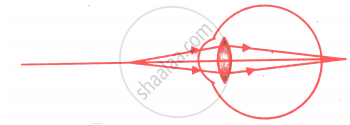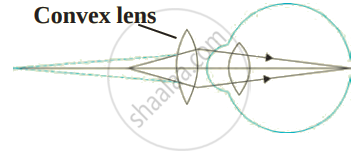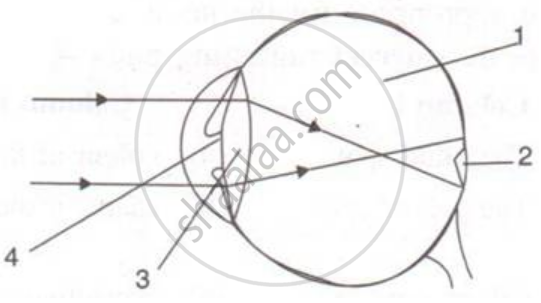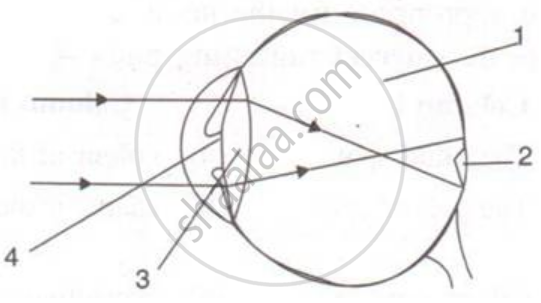Advertisements
Advertisements
प्रश्न
Given below is a diagram showing a defect of vision. Name the defect of vision and draw an accurately labelled diagram to correct this defect.

उत्तर
Name of defect: Farsightedness or hypermetropia
Correction of Farsightedness:

APPEARS IN
संबंधित प्रश्न
In a Std. X class out of 40 students 10 students use spectacles, 2 students have positive power and 8 students have negative power of lenses in their spectacles.
Answer the following questions:
(1) What does the negative power indicate?
(2) What does the positive power indicate?
(3) Generally which type of spectacles do most of the students use?
(4) What defect of eyesight do most of the students suffer from?
(5) Give two possible reasons for the above defect.
What is myopia?
List three common refractive defects of vision. Suggest the way of correcting these defects.
Explain two possible reasons of myopia. How can it be corrected? Explain with a suitable diagram.
Name the defect of vision in a person:
whose near point is more than 25 on away.
What is the other name of old age hypermetropia?
What is the far point of a person suffering from myopia (or short-sightedness)?
Where is the near point of a person suffering from hypermetropia (or long-sightedness)?
Your friend can read a book perfectly well but cannot read the writing on blackboard unless she sits on the front row in class.
Is she short-sighted or long-sighted?
A student sitting in the last row of the class-room is not able to read clearly the writing on the blackboard.
Name the type of defect he is suffering from.
What are the two most common defects of vision (or defects of eye)? How are they corrected?
The near-point of a person suffering from hypermetropia is at 50 cm from his eye. What is the nature and power of the lens needed to correct this defect? (Assume that the near-point of the normal eye is 25 cm).
The defect of vision which cannot be corrected by using spectacles is:
(a) myopia
(b) presbyopia
(c) cataract
(d) hypermetropia
A young man has to hold a book at arm's length to be able to read it clearly. The defect of vision is:
(a) astigmatism
(b) myopia
(c) presbyopia
(d) hypermetropia
A person can read a book clearly only if he holds it at an arm's length from him. Name the defect of vision:
if the person is an old man
A person can read a book clearly only if he holds it at an arm's length from him. Name the defect of vision:
if the person is a young man
Which part of the eye is grafted in a needy patient from a donated eye?
What is meant by optical illusion? Give one example.
Explain the terms ‘adaptation’ and ‘accommodation’ with reference to the eye.
Have a look at the posture of this girl who is reading a book and answer the questions which follow:

Name the problem she is facing.
Write whether the following is true or false:
A convex lens is used for correcting myopia.
Given below is a diagram depicting a defect of the human eye? Study the same and answer the question that follow:

Give two possible reasons for this defect of the eye in human beings.
Given below is a diagram depicting a defect of the human eye? Study the same and answer the question that follow:

Name the parts labeled 1 to 4.
Given below is a diagram depicting a defect of the human eye? Study the same and answer the question that follow:

Draw a labeled diagram to show how the above mentioned defect is rectified using the lens named above.
Differentiate between:
Myopia and Hypermetropia.
Explain the Term: Presbyopia
With respect to human eye explain:
(i) How is the image formed on the retina?
(ii) How is the amount of light entering the eye-controlled?
(iii) What type of lens is used for the correction of ‘Long sight’ defect?
(iv) With the help of a ray, diagram show the defect of the eye and then its correction after the use of a lens.
Due to elongation of _______ and increase in curvature of the eye lens, a person cannot see distant objects clearly.
Nearsightedness: elongated eyeball : : farsightedness: _______
Nearsightedness : concave lens : : farsightedness : _______
Differentiate the eye defects: Myopia and Hypermetropia
Myopia and hypermetropia can be corrected by:
Match the following:
| Column - I | Column - II |
| 1. Retina | a. Path way of light |
| 2. Pupil | b. Far point comes closer |
| 3. Ciliary muscles | c. near point moves away |
| 4. Myopia | d. Screen of the eye |
| 5. Hypermetropia | e. Power of accommodation |
Name the following:
Two kinds of accomodations.
